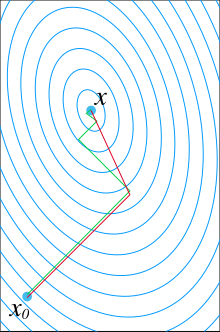Krylov subspace
From Wikipedia, the free encyclopedia
In
linear algebra, the order-
r Krylov subspace generated by an
n-by-
n matrix
A and a vector
b of dimension
n is the
linear subspacespanned by the images of
b under the first
r powers of
A (starting from
A0 = I), that is,
-

It is named after Russian applied mathematician and naval engineer
Alexei Krylov, who published a paper on this issue in 1931.
[1]
Modern
iterative methods for finding one (or a few) eigenvalues of large
sparse matrices or solving large systems of linear equations avoid matrix-matrix operations, but rather multiply vectors by the matrix and work with the resulting vectors. Starting with a vector,
b, one computes
Ab, then one multiplies that vector by
A to find
A2b and so on. All algorithms that work this way are referred to as Krylov subspace methods; they are among the most successful methods currently available in numerical linear algebra.
The best known Krylov subspace methods are the
Arnoldi,
Lanczos,
Conjugate gradient,
GMRES (generalized minimum residual),
BiCGSTAB (biconjugate gradient stabilized), QMR (quasi minimal residual), TFQMR (transpose-free QMR), and MINRES (minimal residual) methods.
References

